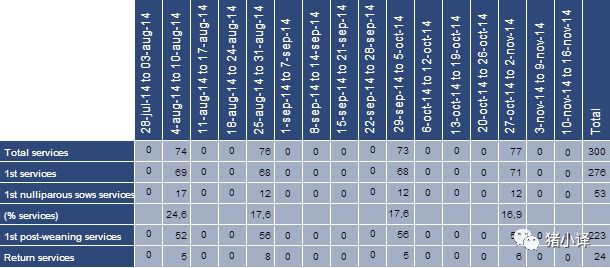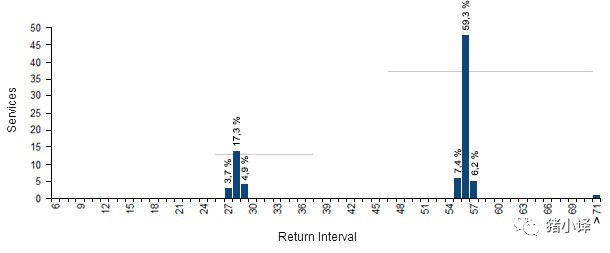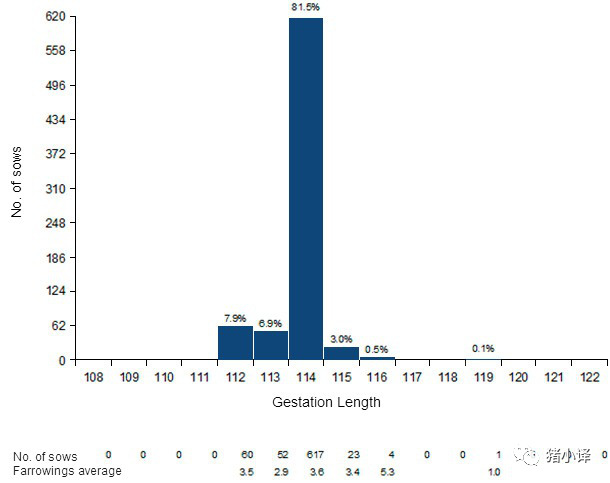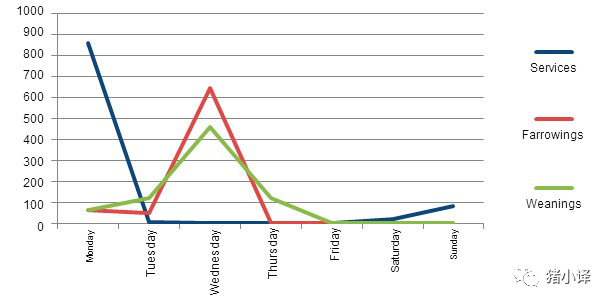看国外:批次化管理中激素的应用案例与分析(1)
来源:猪小译 2020-04-16 15:26:15| 查看:次
批次化管理中激素的应用案例与分析(1)
激素产品或与激素产品具有相似作用的同系化合物早已在母猪上广泛使用。此类产品使用的目的是安排与母猪相关的事情(如在特定的日期发情或分娩)或引起母猪不能自发产生的生理状态(如乏情期母猪诱导发情)。
The use of hormone based products, or homologues that perform the same function, has long become widespread in sows. The key objectives of the use of these products are scheduling events related to the sows (e.g. heat or farrow scheduling on a particular date), or causing physiological states in the sows that are not capable of causing them themselves (e.g. oestrus induction in anoestrus sows).
接下来,是一个小型猪场大规模使用激素的案例(存栏母猪325头),采用4周一批次生产系统,平均哺乳期为21天。
Next, a case of intensive use of hormones is shown in a small farm (325 productive sows) working on a 4-week batch system, with a consequent average lactation length of 21 days.
同期发情
Oestrus synchronization
初产母猪使用激素。如前所述,猪场每4周配一次种。下表显示了初产母猪在配种周内的分组情况;所有母猪在此周期外均未进行人工授精,且达到的数量总是非常相似。
Nulliparous sows are already given hormones. As mentioned before, services in the farm happen every four weeks. The following table shows how all nulliparous sows are grouped to be serviced within the mating week; none of them is inseminated outside those periods, and the number achieved is always very similar.
表1:每周配种情况-16周期间
Table 1. Services per week —16 week period.

此外,此表不仅显示了初产母猪,而且显示了猪场其它所有母猪(断奶,返情母猪)总是在配种周内配种,故可严格保持特定的批次。也就是说,所有的发情均在这些周发生(断奶,返情母猪)。返情如下所示:
In addition, this same table shows how not only nulliparae, but also the rest of the sows in the farm (weaned, returns) are always serviced within the mating week, so that batches are strictly maintained. In other words, all oestruses (weaned sows and returns) are scheduled to take place in such weeks. Returns are distributed as follows:
图1:每个返情间期的返情状况-1年时间.
Graph 1. Returns distribution per return interval —one year period.

此图显示,所有的返情都发生在2个时间点,约为28天和56天,与配种后1或2个批次一致。此案例,对非周期返情的母猪,在27和30天直接配种,其它返情母猪不进行配种(循环周期1,循环周期2,和后期循环),但在配种后56天用激素做同期发情。
The figure shows how returns are grouped into two intervals, around 28 and 56 days, coinciding with one or two batches after the service. In this case, the acyclic returns between 27 and 30 days are serviced directly, while the rest of returns (cyclic 1, cyclic 2 and late cyclic) are not serviced, but synchronized with hormones to come into heat about 56 days after the service.
下表显示断奶母猪断奶到第一次配种间期分布情况。
As per weaned sows, the following table shows the distribution of their weaning-to-1st service interval.
表2: 断奶母猪断奶到第一次配种间期分布情况-1年.

此案例最显著的特点是没有晚期配种;几乎100%的母猪在断奶后7天内进行配种。故对母猪使用激素以迫使其再次发情;由于所有的配种均发生在同一天,猪场可能在小母猪和经产母猪均使用激素产品。断奶后使用激素,可诱导排卵,并使所有母猪同期发情。
Most notable in this case is that there are no late services; virtually 100% of sows are serviced before the 7th day post-weaning. In this case, the sows are "forced" to come into heat again by using hormones; they are probably using next generation hormones both in gilts and in multiparous sows, since all services are on the same day. By applying these hormones after weaning, ovulation is induced, and heat synchronized in all sows.
如前所述,猪场严格执行所有母猪的同期发情,从而维持严格的配种批次。
As we have seen so far, the farm controls and perfectly synchronises all its sows heats, thus maintaining strict service batches.
分娩同期
Farrowing synchronization
下图描述了分娩舍的工作-在此为分娩本身,也严格控制。下图为该猪场的妊娠期长度柱状图。
The graph below shows how tasks in the farrowing rooms —in this case the farrowing itself—, are also strictly programmed. This is the farm's Gestation Length Histogram.
图2:妊娠期长度柱状图-1年
Graph 2. Gestation Length Histogram —one year period.

平均长度较低,为113.8天,图示分布情况明显的显示了猪场在妊娠114天时对所有母猪进行同期分娩(早产案例除外)。
The average length is low, 113.8 days, and the distribution clearly shows how the farm synchronises all its sows' farrowing (except for the early farrowing cases) on day 114 of gestation.
为什么同期?第一部分
Why synchronize? First part
尽管激素在大部分猪场使用,如此大规模的使用激素比较少见。因为与“自然”生产系统相比,使用激素增加了成本和管理工作量,我们可以问自己以下问题:为什么我们选择该猪场的管理系统?或者为什么如此早诱导分娩?
Even though hormones are used in most farms, it is very unusual for them to do it at such an intensive level. Since the use of these products has a cost and implies increased management tasks compared to other more "natural" systems, we could ask ourselves the following questions: Why did we choose this management system in this farm? Or why, for example, is farrowing scheduled so soon?
下图对此作出了很好的解释。该图表明一周每天的主要工作分布情况(配种,分娩和断奶)
The following chart explains the rationale for this operation very well. This graph shows the distribution, by day of the week, of the main tasks in the farm (service, farrowing and weaning).
图3:一周每天主要的工作分布情况-一年
Graph 3. Task distribution by day of the week —one year period.

该图明显表明主要工作主要集中在周一和周三,周六到周日几乎没有重要的事情:
It clearly shows that the main tasks are carried out between Monday and Wednesday, there being practically no important events from Thursday to Sunday:
无论断奶日期,所有的配种均安排在周一(事实上,少数在周日配种的母猪也是如此安排的)。这样以来,所有的母猪均在周一进行人工授精。
Services, regardless of the weaning day, are scheduled to happen always on a Monday (in fact, the few services that happened on a Sunday were also scheduled like that). This way, all sows are inseminated during the first days of the week.
鉴于周一配种,计划在妊娠114天生产,故分娩在周三。如此以来,周三专注于母猪产仔,仔猪出生第一天的护理-需要额外的照顾,从周三到周五,周末空闲。
Since services are on Mondays, farrowings are scheduled to 114 days, to fall on a Wednesday. This way, Wednesdays are dedicated to attending sows at farrowing, and the first days of the piglets' lives —in which they require more attention—, go from Wednesday to Friday, leaving weekends free.
断奶在周三进行(这是猪场唯一一个允许偶尔改变的程序,偶尔在周二或周四进行)。周三断奶再一次使周末空闲,因为断奶前2天为周四和周五。
Most weanings fall on a Wednesday (although this is the only point where some sporadic changes are allowed in the farm, occasionally weaning on a Tuesday or a Thursday). Once again, weaning on a Wednesday leaves weekends free, since the first two days after weaning are Thursday and Friday.
这种严格的安排使猪场在工作日更加专注于需要更多精力/工作的重要事件和时期,从而达成一种理想的工作安排。进而保证了合理的工作安排,并增加员工的福利,因为可提前安排工作和假期。
This strict schedule allows the farm to concentrate all the important events, and time periods where more attention/work is required, within the working days, thus achieving an optimal schedule of tasks. Consequently, proper organization of work is assured, which will increase the workers' welfare, since maintenance tasks and holidays can be planned in advance.
温馨提示:
1、本文由防非复养整理翻译,如需转载请联系我们
2、来源:https://www.pig333.net
PS:
批次化管理既可以提高生产效率与管理水平,提高猪群均匀度,更利于生物安全、利于非瘟防控。
通过批次化管理接触猪的次数大幅减少、销售频率大幅降低。
批次化管理值得大家学习。
服务热线:400-808-6188
Copyright©2010-2022 https://www.zhuwang.cc